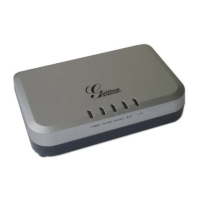The number of ports that can be managed while in NAT router mode.
Range: 0 – 4096, default is 1024. Typically one port per connection.
NAT TCP idle timeout in seconds. Connection will be closed after preconfigured,
timeout if not refreshed. Range: 0 - 3600
NAT TCP idle timeout in seconds. Connection will be closed after preconfigured,
timeout if not refreshed. Range: 0 – 3600, default is 300
The maximum uplink bandwidth permitted by the device. This function is
disabled by default. The total bandwidth can be set as: 128K, 256K, 512K, 1M,
2M, 3M, 4M, 5M, 10M or 15M. The primary function of this setting is to limit the
uplink bandwidth for the device internal system, signaling and NATed traffic.
Example: When 512k is configured, there will be at least 512kbps limited for
internal system, signaling and NATed traffic. Voice or RTP stream will never be
limited. See figure 3.
The maximum downlink bandwidth permitted by the device. This function is
disabled by default. The total bandwidth can be set as: 128K, 256K, 512K, 1M,
2M, 3M, 4M, 5M, 10M or 15M. The primary function of this setting is to limit the
download bandwidth for the device internal system, signaling and NATed traffic.
Example: if 128 is configured, there will be at least 128kbps limited for internal
system, signaling and NATed traffic. Voice or RTP stream will never be limited.
See figure 3.
When set to “Yes”, the HT502 acts as an UPnP gateway for your UPnP enabled
applications. UPnP = “Universal Plug and Play”
Reply to ICMP on
WAN Port
Default is No. When set to “Yes”, the HT502 responds to the PING command from
other computers, but is also made vulnerable to DOS attacks.

